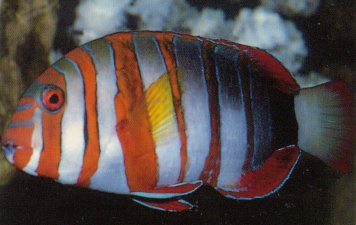 The harlequin tusk (Choerodon fasciatus) belongs to the family of wrasses. It has orange mottled bands. Each band is etched by delicate blue-violet ribbons. Anteriorly, between the orange bands is silvery-white, turning to dark grey-black posteriorly. With big protruding tiger-like fangs, the tusk looks very menacing indeed, capable of doing harm to other tank mates.
The harlequin tusk (Choerodon fasciatus) belongs to the family of wrasses. It has orange mottled bands. Each band is etched by delicate blue-violet ribbons. Anteriorly, between the orange bands is silvery-white, turning to dark grey-black posteriorly. With big protruding tiger-like fangs, the tusk looks very menacing indeed, capable of doing harm to other tank mates.
While this is true, it is the authors experience that the harlequin tusk is actually quite peaceful and does not bother other resident aquarium inhabitants. The tusk, however, does not accept undue punishment and is very capable of fending off an attacker.
Choosing Your Tusk
Scrutinise the fish carefully for signs of parasitic infection such as Cryptocarion irritans (White Spot) or Oodinium ocellatum (coral fish disease or marine velvet) as these parasites can quickly infect your entire community of fishes. As a proud owner of a Tusk, you must be aware that copper based treatments used for the eradication of Cryptocarion and Oodinium is an absolute no no. Other less effective treatments need to be used which generally mean longer exposure times to medication. In some cases it may still be necessary to remove the Tusk and treat the infected system with copper based remedies. Hence the old adage - prevention is better than cure.
Thus when introducing new arrivals it is well worth taking a few precautionary measures. The best method of prevention of unwanted infections is to quarantine all new arrivals. A small investment in quarantine facilities run by a simple undergravel filter will prevent many unnecessary problems. I know it is tempting to put a new acquisition straight into its new home, as we marine enthusiasts are an impatient breed. If you can avoid this temptation, you will be rewarded by a healthy display of beautiful inquisitive inhabitants. If due to limitations of space you're not able to provide quarantine accommodation, most marine dealers will hold a fish for an agreed period of time to ensure as far as possible that the specimen is in a good, healthy condition prior to purchase.
Aquarium Compatibility
As has been mentioned the Tusk is a peaceful fish, but be aware of its dentition as it is capable of destroying fishes that are too small. It must not be placed in an invertebrate or reef system, as it will surely feast upon any crustaceans. Ideal tank mates are as follows: large angels, pygmy angels (depending on the size of your Tusk), lionfish, butterflies, surgeons and groupers. Other wrasses may be added, but be aware for the potential of aggressive behaviour. The author has successfully kept a dragon, pinkface, twin spot and a cleaner wrasse with a harlequin without any problems. At present a moon wrasse (Thalassoma lunare) is housed with the Tusk. This causes a few fireworks every now and then which mainly occurs during feeding times, as both are voracious feeders. However, they co-exist without either doing the other serious injury. Therefore proceed with caution. Generally speaking, less competitive wrasses will make better additions. If at all possible try not to add other wrasses to a harlequin's tank once it has been acclimatized to its quarters for a long period of time. You might find your new addition being relentlessly "hawrassed".
Aquarium Care
This fish has exquisite colours, a great temperament and is constantly cruising the length of the aquarium. You will always be greeted with big orange intelligent eyes by your tusk when you approach the aquarium as he awaits to be fed his favourite foods. Tusks like all fleshy foods, such as: muscle, cockle, fish and various different types of shrimp. These fishes will also join the vegetarians during feeding time, eating such foods as: peas and chopped spinach, algae wafers. This demonstrates the variety of foods Tusks will accept with gusto showing that dietary needs are easily met.
Harlequins are fairly hardy once they have been acclimatized and are not too fussy about water quality, provided that basic parameters such as pH (8.2), nitrite (0ppm) are maintained. Regular water changes, about 15% carried out every two weeks will control nitrate levels and prevent them from becoming excessive. The aquarium itself should have plenty of rock work in the form of tuffa rock. Tusks enjoy cruising in and out of cliffs and overhangs in search of any morsels of food that may have been overlooked during feeding time.
If you like to have some greenery, your tusk won't graze upon your lush bed of Caulerpa. In some heavily populated fish only systems, where lighting and water quality may not be entirely up to scratch, you may well find that the free floating red seaweed algae thrives while the Caulerpa succumbs. Even though harlequins have the potential to grow quite large by aquarium standards (30cm) they can be housed in an aquarium of about 300L. They are quite slow growing, not increasing in size by more than about 3cm per annum, so it will be quite some time before your Tusk may need bigger quarters or fewer tank mates to accommodate its increase in size. The Harlequin Tusk is one of the most resplendent wrasses to grace any community aquarium.

